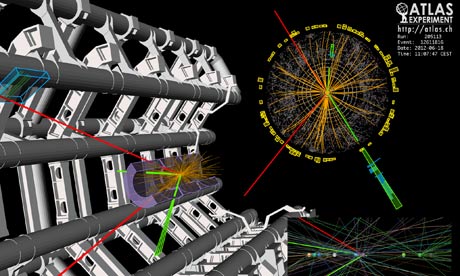Good morning all.
Two teams of physicists at the Cern laboratory near Geneva are preparing today to announce their latest efforts to discover the Higgs boson.
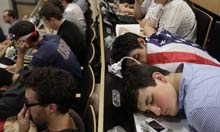 Participants take a rest early before the opening of the seminar. Photograph: Denis Balibouse/AFP/Getty Images
Participants take a rest early before the opening of the seminar. Photograph: Denis Balibouse/AFP/Getty Images
The elusive "God particle" has become the most sought-after particle in modern science. Its discovery would be proof of an invisible energy field that fills the vacuum of space, and excitement in the scientific community is at fever pitch.
Peter Higgs, the Edinburgh University physicist who proposed the idea of the particle in 1964, is flying in to Geneva, as are two other men who published similar theories at around the same time: François Englert, professor emeritus at the Free University of Brussels (ULB) in Belgium, and Tom Kibble, professor emeritus at Imperial College London.
There have been rumours, speculation, and, last night, even an apparent leak from the laboratory when a video announcing the discovery of a new particle was accidentally posted on its website.
The Guardian's Ian Sample has flown to Geneva and I'll be live-blogging this potentially historic morning on this page.
Now, two video links for your viewing pleasure.
This one is to Cern's own live stream from where the scientific session is due to start at 9am local time (8am British time) - and subsequent press conference - will be held.
And here is a video from the Guardian's own resident boffin, science correspondent Ian Sample. Heroically, he attempts to explain the Higgs boson by means of a tray from our canteen and some coloured ping pong balls.
 British physicist Peter Higgs (right) arrives at the seminar. Photograph: Fabrice Coffrini/AFP/Getty Images
British physicist Peter Higgs (right) arrives at the seminar. Photograph: Fabrice Coffrini/AFP/Getty Images
Clapping for Peter Higgs, who has just arrived in the auditorium. Now, the anticipation mounts.
And we're off. First up is Joe Incandela, the leader of the team using the CMS detector to search for new particles. He'll be followed by Fabiola Gianotti from the other team using the Atlas detector.
He says the results are "very strong, very solid".
As Incandela speaks, the brilliant Ian Sample is live-tweeting from Cern.
I've been told that anyone who thinks they haven't found a new particle after this has lost touch with reality. #cern #lhc #higgs #ichep2012
— Ian Sample (@iansample) July 4, 2012
Incandela "Many people went many days without sleep." #ichep2012 #lhc #cern #higgs
— Ian Sample (@iansample) July 4, 2012
And we're keeping our observations extremely serious in keeping with the potentially historic nature of the day.
Does Joe Incandela (cms spokesman) not look a little like George Clooney? #ichep2012 #lhc #higgs #lhc
— Ian Sample (@iansample) July 4, 2012
I'm not going to lie: this is a little above my GCSE Physics.
Reuters has just posted a flash update that claims Cern scientists have discovered a new sub-atomic particle that could be the Higgs boson.
Here's the Reuters take.
Scientists at the CERN research centre have discovered a new subatomic particle that could be the elusive Higgs boson, which is believed to be crucial in the formation of the universe.
"I can confirm that a particle has been discovered that is consistent with the Higgs boson theory," said John Womersley, chief executive of the UK's Science & Technology Facilities Council, at an event in London.
Joe Incandela, spokesman for one of the two teams hunting for the Higgs particle told an audience at CERN near Geneva: "This is a preliminary result, but we think it's very strong and very solid."
Big applause.
Combined significance of all results 5 standard deviations. Room breaks into applause, whistles #Higgs #LHC
— Anil Ananthaswamy (@edgeofphysics) July 4, 2012
Here's Ian's take.
incandela: says when they combine the results for two decay channels they get five sigma for the #Higgs. That's enough for a discovery.
— Ian Sample (@iansample) July 4, 2012
More interpretative tweets courtesy of those who can interpret these results.
And combined - 5 sigma. Round of applause. That's a discovery of a Higgs - like particle at CMS. They thank LHC for the data!
— Brian Cox (@ProfBrianCox) July 4, 2012
5 sigma is the usual particle physics threshold for discovery. It roughly means that you're 99.9999% sure
— Brian Cox (@ProfBrianCox) July 4, 2012
Incandela has finished. There's warm applause. His summary:
All channels combined, sensitivity is 4.9 sigma. All results are consistent.
— Brian Cox (@ProfBrianCox) July 4, 2012
We have observed a new boson with a mass of 125.3 plus or minus 0.6 GeV at 4.9 sigma standard deviation-Incandela. Applause!!!
— Anil Ananthaswamy (@edgeofphysics) July 4, 2012
The American physicist Sean Carroll is live-blogging this announcement over at Discover magazine.
His reflection from Incandela's presentation is:
Huge question ongoing: are we seeing a standard Higgs with a couple of statistical fluctuations, or are differences in different channels the sign of something new?Easiest way to make different channels mismatch is to add new particles to your theory that couple to the Higgs, and enter as virtual particles that modify different decay rates.
Full employment for both experimentalists and theorists!
Up now is Fabiola Giannotti, leader of the 3,000-strong group that works on the collider's five-storey Atlas detector.
Ian Sample wrote a little piece about her and her work at the LHC last year.
The appointment put her in the top ranks of a profession dominated by men. She came to physics from an education steeped in ancient Greek, philosophy and the history of art – she had also trained as a pianist at the Milan Conservatory.But she ultimately chose physics to answer the big question of why things are as they are. "Physics is, unfortunately, often seen as a male subject; sterile and without charm or emotion," she told the Cern magazine. "But this is not true, because physics is art, aesthetics, beauty and symmetry."
A welcome summary in layman's terms from Brian Cox.
In simple language, CMS have discovered a new boson, and it behaves like the Standard Model Higgs
— Brian Cox (@ProfBrianCox) July 4, 2012
AP's take on Incandela's presentation.
One of the two independent teams at the world's biggest atom smasher says it has found strong evidence of a new subatomic particle that looks like the one believed to give all matter in the universe size and shape.Joe Incandela, leader of one of the teams, told scientists at the European Center for Nuclear Research, or CERN, that the data has reached the level of certainty needed for a discovery.
But he has not yet confirmed that the new particle is indeed the tiny and elusive Higgs boson, popularly referred to as the "God particle."
The New Scientist, reporting from the auditorium, says Cern has pre-empted Gianotti. And the results from ATLAS also look exciting.
CERN PR just circulating room, pipping Gianotti to the post: #ATLAS sees #Higgs at around 126 Gev with 5 sigma certainty. Wow.
— New Scientist (@newscientist) July 4, 2012
"Both experiments observe a new particle in the mass region around 125-126 GeV," confirms a press release from Cern.
Gianotti- who is still speaking- is quoted in this release as saying:
We observe in our data clear signs of a new particle, at the level of 5 sigma, in the mass region around 126 GeV. The outstanding performance of the LHC and ATLAS and the huge efforts of many people have brought us to this exciting stage, but a little more time is needed to prepare these results for publication.
Incandola, from CMS, adds:
The results are preliminary but the 5 sigma signal at around 125 GeV we're seeing is dramatic. This is indeed a new particle. We know it must be a boson and it's the heaviest boson ever found. The implications are very significant and it is precisely for this reason that we must be extremely diligent in all of our studies and cross-checks.
And Sergio Bertolucci, research director of CERN, says:
It's hard not to get excited by these results. We stated last year that in 2012 we would either find a new Higgs-like particle or exclude the existence of the Standard Model Higgs. With all the necessary caution, it looks to me that we are at a branching point: the observation of this new particle indicates the path for the future towards a more detailed understanding of what we're seeing in the data.
The results presented today are labelled preliminary, the statement adds.
They are based on data collected in 2011 and 2012, with the 2012 data still under analysis. Publication of the analyses shown today is expected around the end of July. A more complete picture of today's observations will emerge later this year after the LHC provides the experiments with more data.
The next step will be to determine the precise nature of the particle and its significance for our understanding of the universe. Are its properties as expected for the long-sought Higgs boson, the final missing ingredient in the Standard Model of particle physics? Or is it something more exotic? The Standard Model describes the fundamental particles from which we, and every visible thing in the universe, are made, and the forces acting between them. All the matter that we can see, however, appears to be no more than about 4% of the total. A more exotic version of the Higgs particle could be a bridge to understanding the 96% of the universe that remains obscure.Positive identification of the new particle's characteristics will take considerable time and data. But whatever form the Higgs particle takes, our knowledge of the fundamental structure of matter is about to take a major step forward.
First reaction from Peter Higgs has just landed in my inbox. According to a statement sent by Edinburgh University, the physicist says he is "astounded" at the speed with which the results have emerged and is preparing to celebrate.
Scientists at CERN are to be congratulated on today's results, which are a great achievement for the Large Hadron Collider and other experiments leading up to this.
I am astounded at the amazing speed with which these results have emerged. They are a testament to the expertise of the researchers and the elaborate technologies in place.
I never expected this to happen in my lifetime and shall be asking my family to put some champagne in the fridge.
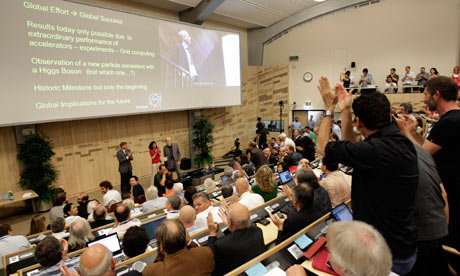 Participants applaud after the presentation of the Atlas experiments. Photograph: Denis Balibouse/AP
Participants applaud after the presentation of the Atlas experiments. Photograph: Denis Balibouse/AP
Gianotti is still presenting Atlas's results but the reaction is already pouring in. Here's are the first few paragraphs from Ian Sample's first take on today's momentous announcement.

There comes a time in a scientist's life when the weight of evidence can no longer be ignored. That moment came today for physicists at Cern, home of the Large Hadron Collider near Geneva, who announced overwhelming evidence for the obscure but profoundly important Higgs boson, the particle that sparked the greatest hunt in modern science.In presentations given to a packed auditorium at the laboratory on Wednesday morning, and webcast around the world, the leaders of two research teams, who worked independently of each other, said they had spotted a new particle amid the microscopic flashes of primordial fire created inside the world's most powerful atom smasher.
Cern stopped short of claiming official discovery of the Higgs boson, even as many physicists conceded the evidence was now so compelling they had surely found the missing particle.
Formal confirmation of the discovery is expected within months, though it could take several years for scientists to work out whether they have found the simplest kind of Higgs particle that theories predict, or part of a more complex picture: for example, one of a larger family of Higgs bosons. The discovery of more than one kind of Higgs particle would open the door to an entirely new realm of physics.
"#CERN" is trending worldwide. As is #Higgs, and #GodParticle (sorry), and ATLAS. No #Higgsteria yet though, despite a valiant effort by social media types.
Today's discovery is "unbelievably exciting", according to Harvard physicist Lisa Randall.
She told the Guardian:
I really didn't expect this. They got enough data and improved analysis to the point where we know about a new particle months before I expected (based on
asking lots of people)! It is unbelievably exciting.
Tommaso Dorigo, a scientist on the CMS experimental team at Cern, had this evaluation for Ian over in Geneva:
Is it a Higgs boson or not? Well, it has been found using techniques tuned for the Standard Model Higgs. A different object might have stepped in, but it is quite unlikely in my humble opinion.
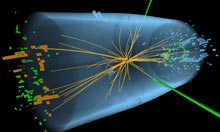 A representation of traces of a proton-proton collision in the search for the Higgs boson, released by Cern. Photograph: AFP/Getty Images
A representation of traces of a proton-proton collision in the search for the Higgs boson, released by Cern. Photograph: AFP/Getty Images
Cheers and applause for Gianotti now.
ATLAS - round of applause + cheers. 5 sigma discovery at 126.5 GeV
— Brian Cox (@ProfBrianCox) July 4, 2012
Standard Model expectation would be 4.6 sigma, so compatible with SM prediction
— Brian Cox (@ProfBrianCox) July 4, 2012
"I'm not done yet; there's more to come!" she laughs. She has these guys in the palm of her hand.
Some physicists are being more certain about interpreting these results than others. For Professor Stefan Söldner-Rembold, Professor of Particle Physics at the University of Manchester, "there is no doubt that the Higgs particle exists".
Today we have witnessed a discovery which gives unique insight into our understanding of the universe and the origin of the masses of fundamental particles. There is no doubt that the Higgs particle exists and we now have to understand its properties and whether it behaves exactly as predicted by theory.
This discovery is the first milestone of the LHC physics programme and opens the door to many more exciting discoveries by the LHC experiments in the next decade.
Rolf Heuer, Director General of CERN, offers this verdict:
As a layman I would say: I think we have it. You agree?
The audience claps. I think that's a yes.
Heuer flashes up on screen a slide that says Cern have discovered "a particle consistent with the Higgs boson- but which one?"
So, while this is undoubtedly a milestone with "global implications", he says, it is also the beginning of a lot more research and investigation. But, he adds, "I think we can be very, very optimistic".
Peter Higgs, who first proposed the idea of this boson in 1964 and is now 83, may have shed a tear or two there- a sight which seems to have got everyone else going too.
Peter #Higgs is crying... it's a great day for physics. I am proud of being a physician :°)
— Manlio De Domenico (@manlius84) July 4, 2012
Peter Higgs crying at conclusion? Perfect. Brilliant day, folks. Can't wait to see what scientists do tomorrow. #Higgs
— Angel (@HavingANemesis) July 4, 2012
Standing ovation at the@Cern #Higgs-Boson announcement, and Prof. Peter Higgs crying with joy. Simply awesome. Over 30 years and $9b cost.
— Ardit Bajraktari (@ardit33) July 4, 2012
Peter Higgs has just been asked to say a few words.
"For me it's a really incredible thing that it's happened in my lifetime," he said, giving his congratulations to everyone involved in what he described as a "tremendous achievement".
Earlier I pointed out that four of the 10 worldwide trends on Twitter were Higgs-related. I erred. There were five- but one of them was Comic Sans.
Turns out that, instead of remarking on the incredible achievements of the physicists at Cern, some people would prefer to ridicule them for presenting their results in a funny font.
CERN need a design partner - Comic Sans for a serious presentation of breakthrough findings! Really? theverge.com/2012/7/4/31366…
— James Penrose (@jcpenrose83) July 4, 2012
CERN's Higgs presentation just added weight to the theory that Comic Sans is a terrible font.
— HAL 9000 (@HAL9000_) July 4, 2012
Press conference time. More layman's terms please!
First question goes straight to the point: "Have you found the Higgs boson or not?"
Heuer replies that, as he said earlier, in layman's terms, they have "got it".
But as a scientist I say 'what do we have?' We have a boson. Now we have to discover what kind of boson it is.
For anyone who's just joined the fun, you can watch the live stream here.
All the journalists are begging for layman's terms. Rolf Heuer of CERN is trying all kinds of inventive allegories to explain the discovery. Is it working? Not entirely sure.
Were they surprised by how quickly they made this discovery? After all, points out one journalist, "supersymmetry" was what they were expected to hit upon first.
Yes, replies Heuer. Gianotti agrees, attributing the speed to the "impressive performance of the accelerator" and the experiments which have worked very well.
Incandela says that this discovery could actually help in the search for supersymmetry.
In fact, the existence of a Higgs-like boson actually is a very strong motivation for the existence of supersymmetry...We're going to try and hunt it down.
Ooo, we're into Rumsfeldian territory here. A spokesman says they also want to go after the unknown unknowns.
How did the leaders of Atlas and CMS feel upon completing this discovery? Like "walking on air", says Incandela.
It was a magnificent moment to see the reaction of the community.
Gianotti praises the "dedication, the competence, the talent" of everyone in her team, Atlas.
John Ellis of CERN has emailed this evaluation to the Guardian's Ian Sample.
There is no doubt that something very much like the Higgs boson has been discovered. The strengths of the signals observed independently by CMS and ATLAS are completely convincing, and they are supported by data from the Tevatron experiments CDF and D0.
Now the emphasis will shift to verifying the properties of the particle that has been discovered: does it have spin zero? Does it couple to other particles proportional to their masses?
The discovery will open up a new era in particle physics, as we look for deviations from the properties expected in the Standard Model, and for other physics beyond the Standard Model that might be connected, such as the nature of dark matter.
Heuer has just had another valiant effort at explaining the science in terms a small child would understand.
How close is what they've found to the Higgs boson, asks a journalist? It's as if, he explains, you think you see your best friend- but is it your best friend or your best friend's twin? Basically: more work is needed. He concluded:
Ask me again in three, four years.
We're asking commenters to help us explain the Higgs Boson. My colleague Hannah Waldram has passed me on these interesting contributions:
It's like there has been a figure in black in the ballet that the other dancers can see so dance around and with but we can't see. We see the shape of the ballet but cannot, until now see all the dancers.
It's like zoologists trying to determine if they've discovered a new species of butterfly by looking at a meadow through binoculars. From 16 miles away.
 Shiv Malik
Shiv Malik
Our very own Shiv Malik has also put his scientist's hat on to try to explain
One talking point is how reliable the results are. This is based on how certain physicists are about the data they have. The way this is normally measured is through standard deviation i.e. the 1-5 sigma that we've been hearing about.This handy explainer graphically shows what deviation is on a usual distribution graph or a bell curve, where most results are based around the middle but there are also some extreme results at either end.
Something like plotting height amongst a big population of 35 year old males would give you a bell curve graph like this. Tall and short at either end but most people are say, 5 Ft 8". Five sigma from the standard deviation therefore means many steps away from the norm. In terms of height it would be say, adults males who are either 2ft or 7ft tall i.e. very unusual.
But now reverse engineer the exercise. Imagine you are looking at 7ft people and you want to know how likely it is that this is a strange result from the middle or the norm. How would you work this out? How would you come up with a number to represent this? Well, looking at the data, plotting the graph, you could say that 7ft adult males represent 5 sigma deviation from the norm, so you are pretty sure that this is an odd or unusual result and therefore worth being (statistically speaking) interested about. This is what those at CERN have been saying today.
As the journalists in Geneva continue to beg the Cern guys for replies they can understand, here at the Guardian we are begging you to help us explain the Higgs boson.
My colleagues write:
Can you help us break it down into even simpler terms? If you're a scientist, a teacher or a physics fan with a knack for explaining big ideas and small particles, we're imploring you to help.• How would you explain Higgs boson to a 7-year-old?
• What analogy best explains what's happening at Cern?
• Can it be described in 200 words?
A bold Reuters journalist just asked them to provide their own metaphors for the Higgs boson. Alas. "The podium is metaphorless," replied Heuer.
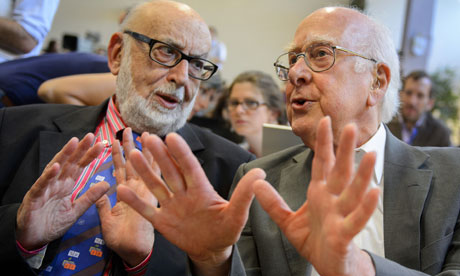 British physicist Peter Higgs (right) speaks with Belgium physicist Francois Englert. Photograph: Fabrice Coffrini/AFP/Getty Images
British physicist Peter Higgs (right) speaks with Belgium physicist Francois Englert. Photograph: Fabrice Coffrini/AFP/Getty Images
Ok, that's that. The press conference is over.
Throughout, Peter Higgs refused to make any comment other than to praise the achievement and to say he was making no further comment. He obviously didn't want to hog the limelight, which will only endear him further to his new legion of Twitter fans.
On a lighter note, here's a storify of Twitter jokes about the Higgs boson as collated by Hannah Waldram.
Sure there are plenty more to come, so tweet your best to @guardian on #higgsjokes.
You can now read Ian Sample's excellent take on this morning's announcement at length here.
And, for those of who still a little in the dark, check out this fun explainer video by PHD Comics on Vimeo. Thanks to Koos Fuite below the line for the spot.
My colleagues Hannah and Laura have been collating some of the lovely explanations coming in in response to our plea to explain the Higgs boson in a way a 7-year-old child would understand.
My favourite- and certainly the most inventive- is egorulz's effort below the line.
Once upon a time in a far away land, there were two rival families: Fermions and Bosons. Fermions were famous for their peculiar half spin dance. Electrons, protons and quarks were all Fermions.The Bosons however were into full spinning though and despised half spin. Photons and Gluons were Bosons. It was rumored that Bosons had a long lost elder brother called Higgs Boson who had been missing for a long long time.
One day a wise old man came to the land of the feuding families. He told them they should stop quaerlling over half spin and full spin, since they all used to be the same, and that they all used to be massless.
The old man said that, in the beginning of time when the universe was created, everyone was born the same, but then they were immersed in a mysterious field called the higgs field making each of them different except for Photons who remained the same.
He said this mysterious field was made up of the Higgs Boson - the long lost Boson brother.
The families ofcourse refused to believe all this hogwash, and so the old man set about trying to prove his story and bring the Higgs Boson out of his hiding place.
To do this he asked for help from the scientists at CERN.
The family feud is coming to an end, at last.
The science community seems agreed: this is a big moment. But many, like Heuer, are cautioning that this could be just the beginning.
Dr Roberto Trotta, Lecturer in Cosmology at Imperial College London, has this to say, according to the Science Media Centre.
This could be just the first step towards uncovering a completely new layer of reality - the Higgs might lead to the discovery of supersymmetry: the notion that for every known particle there exist a super-particle with a much larger mass.And if supersymmetry is real, then we are on our way to finally crack the mystery of the dark matter in the Universe. Dark matter might be 'the last Highlander' of all supersymmetric particles, the only surviving 'sparticle' from the Big Bang. And we might be on the verge of hunting it down at the LHC.
Professor John Womersley, STFC Chief Executive, said:
Obviously having found a new particle, there is still much, much more to do at the LHC – we need to confirm that this new particle is the reason some particles have tangible mass while others are insubstantial – as proposed by Peter Higgs and other scientists, who predicted that a previously unknown particle must exist for our current understanding of the Universe to work.
And, for Professor Valentin Khoze, Director of Durham University's Institute for Particle Physics Phenomenology (IPPP), this discovery is just opening the door to others that could be even more exciting.
The second part of the story about the Higgs particle is even more exciting as it provides us with a window to new physics - a tool for the exploration of the truly unknown.The next stage will be a detailed and careful study of its properties. Successful completion of this second stage will bring us closer to uncovering new physics, explaining dark matter and other mysteries of the Universe.
Ian Sample has this thought for us:
Stephen Hawking bet Gordy Kane (UMICH) $100 that the Higgs would never be found at Cern. Wonder if he's conceded defeat? #Higgs #ichep2012
— Ian Sample (@iansample) July 4, 2012
Still full of Higgs related questions? CERN theorist Ignatios Antoniadis has had a go at answering some of the public's most pressing queries here.
Broken down into the main points Antoniadis says:
• The newly-discovered particle looks like the Higgs boson but, as its properties have not been fully studied yet, a final label will "only come after further investigations".
• The CERN scientists will specifically be looking at decay rates as these, together with mass, characterise particles. The particle could either decay "with the rates expected from the Standard Model (SM)", or it will decay differently- which will then beg the question of whether the SM needs "small adjustments...or if new physics processes need to be looked for in order to explain its nature". (I think this would be a pretty major upset.)
• The particle, because of its low mass, has allowed the scientific community to rule out theories such as "technicolor" and "some of the theoretical models used in Supersymmetry. However, other supersymmetric or not scenarios could still apply, as well as extra-dimensional theories."
• The good news for theorists is that experimentalists may be able to provide us with this information about decay rates over the next few months.
And if after all this you STILL have questions relating to the-particle-that-may-be-Higgs-but-is-not-for-sure, there'll be a live Q+A taking place at 1pm here.
My colleague Laura Oliver writes:
Got a question about the Higgs boson, Cern or the Large Hadron Collider, but been too afraid to ask? As we report live from Geneva on scientists' latest efforts to find the 'God particle', two leading physics professors will be online to take your questions.From 1pm BST we will have Professor Stefan Soldner-Rembold, professor of particle physics at the School of Physics and Astronomy, University of Manchester, and Professor Andy Parker, professor of high energy physics at the University of Cambridge, available to answer your questions about the Higgs boson.
And some more Higgs trivia (I'm not sure any of it is really trivial, but anyway) courtesy of the Press Association.
Q: What is the Higgs boson and the Higgs field?
A: The Higgs field has been described as a kind of cosmic "treacle" spread through the universe. As particles travel through the treacle they slow down, lose energy and get heavier. The Higgs boson is the force-carrying particle that helps transmit the effects of the Higgs field.
Q: What would the world be like without the Higgs boson?
A: According to the Standard Model theory, it would not be recognisable. Without something to give mass to the basic building blocks of matter, everything would behave as light does, floating freely and not combining with other particles. Ordinary matter, as we know it, would not exist.
Q: How did the Higgs boson get the nickname "the God particle"?
A: A Nobel laureate physicist from Fermilab called Leon Lederman wrote a book in the early 1990s about the search for the Higgs boson. His publishers coined the name as a marketable title for the book, but it's disliked by many scientists.
My colleague Mary Hamilton happens to have a brother with a PhD in quantum mechanics (handy, that), who has spent his lunch break emailing his thoughts on the Higgs announcement and what it all means.
You can read John's thoughts in full below the line but here's his answer to the burning question: was it a standard model Higgs, or something else?
Well, according to today's results, both detectors actually saw a bigger excess in the diphoton channel - i.e. more than would be predicted with a Standard Model Higgs. Also the tau-tau channel showed nothing at all. That could mean that this isn't a SM Higgs which would be what's know in the trade as "cool new science".Having said that, those discrepancies are not yet very significant (<2 sigma) so could just be luck, and one of the two detectors didn't report anything on tau-tau yet.
Professor Stephen Hawking has admitted to the BBC that he's lost his bet that the Higgs particle wouldn't be found (see 12.09pm).
It seems I have just lost $100.
The results, said Hawking, "strongly suggest" that CERN had found the Higgs particle. If its properties turn out to be as expected, he said, "it will be strong evidence for the so-called standard model of particle physics, the theory that explains all our experiments so far."
This is an important result and should guarantee Higgs the Nobel prize but it is a pity in a way because the great advances in physics have come from experiments that gave results we didn't expect.
Brian Cox has been on the airwaves telling the BBC why, for him, this day is one for the history books.
This is without doubt in my opinion the biggest scientific discovery of my lifetime and without doubt one of the biggest scientific discoveries of all time, so I'm tremendously excited... This day will go down as one of the great days in the history of science I think, and that's not overly hyperbolic.
Cox said he almost felt shocked that "such a strange thing" had been shown to be true.
This is a prediction that was made almost 50 years ago. And the prediction is that the universe, everywhere, empty space, everywhere you look, every little cubic centimetre of space in front of you and inside your body and across the universe, is rammed full of Higgs particles, and everything that makes up your body, the little subatomic particles in your hand, are bouncing off them, and that's how they get their mass.
And more than that the theory said that these Higgs particles condensed out into empty space less than a billionth of a second after the universe began. It sounds very esoteric and fundamental. But what we've shown today is that's right. That's actually how the universe works. So it's one of the central planks of our understanding of how everything in the universe works.
And even though, throughout my whole career as a particle physicist of 20 years now, this theory has been there, I think the realisation that it's actually right is quite shocking, actually; I'm quite shocked that such a strange thing has been shown to be true.
We're going to wrap up this live blog now. Thanks for all your illuminating and engaged comments; I can only apologise for my woeful inability to understand almost anything that was said by the clever people of CERN.
For a brilliant write-up of what today means- and, to quote him, why "the real work begins" now- have a look at Ian Sample's latest report from Geneva.

Ian writes:
Months and years of analysis lie ahead to confirm that the particle is the elusive Higgs boson. If so, physicists want to know whether it is the simplest kind of particle put forward in physicists' theories, or something more unusual – and more exciting.

